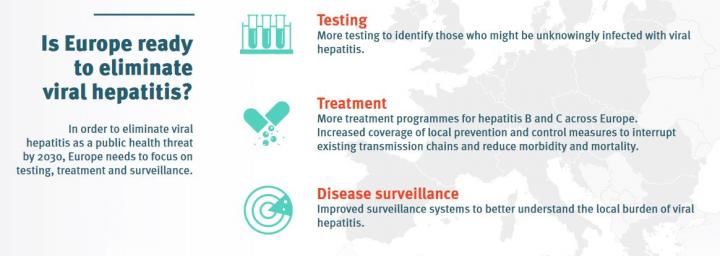ECDC estimate: around 9 million Europeans live with chronic hepatitis B or C

Credit: ECDC
European surveillance data show on-going transmission of viral hepatitis with more than 50 000 newly diagnosed cases of hepatitis B and hepatitis C each year from across the European Union and European Economic Area (EU/EEA). These figures do not provide the full picture of the epidemiological burden, as ECDC estimates that around 9 million Europeans live with chronic hepatitis B or C. This includes many people with an asymptomatic and hence undiagnosed and untreated hepatitis infection, which can lead to liver cirrhosis and hepatocellular carcinoma.
One of the targets of the Sustainable Development Goals (SDG) sets the goal to “combat hepatitis” by 2030. To date, however, there is no standardised system in place to monitor and evaluate the progress made towards the hepatitis targets included in the SDG, the Global Health Sector Strategy on Viral Hepatitis and the World Health Organization’s European Action Plan for the elimination of hepatitis.
Is Europe on target for hepatitis elimination?
For the EU/EEA countries, ECDC developed a monitoring framework with pre-defined indicators for hepatitis B and C, which is closely aligned with the targets and milestones in the European Action plan as well as monitoring and evaluation framework developed by the WHO. It was rolled out at the end of 2018 and the collected data are currently analysed by ECDC.
One of the preliminary results: only a small number of EU/EEA countries are on track to meet targets set for 2020 e.g. regarding diagnoses of chronic viral hepatitis. For hepatitis B, 13 countries were able to provide estimates of the diagnosis rate and for hepatitis C, data came from 18 countries. Four countries (Denmark, Ireland, the Netherlands and Norway) achieved the 2020 target of diagnosing half of all the people with chronic HBV infection. Among the countries reporting HCV data, eight have already achieved the target for next year to diagnose 50% of chronic hepatitis C infections (Finland, France, Iceland, Ireland, Latvia, Slovakia, Slovenia and the United Kingdom). The full results of the first monitoring exercise for viral hepatitis will be published later this year.
These findings illustrate that reaching and testing those at risk of hepatitis infection is still a public health challenge across Europe. Targeted testing is thus an essential element of any strategy to eliminate viral hepatitis across the countries in the European Union and European Economic Area (EU/EEA).
ECDC’s Guidance on integrated viral hepatitis and HIV testing provides options and ideas based on the latest scientific evidence for national or local hepatitis B, C and HIV testing guidelines and programmes. It advocates for a concerted effort to scale up integrated testing strategies or programmes for hepatitis B and C and HIV to try to reduce the large number of those that are currently infected but undiagnosed.
###
Read more on World Hepatitis Day 2019
http://bit.
ECDC Public health guidance on HIV, hepatitis B and C testing in the EU/EEA
http://bit.
ECDC-EMCDDA Guidance on prevention and control of blood-borne viruses in prison settings
http://bit.
World Hepatitis Day 2019
http://bit.
Media Contact
ECDC press office
[email protected]
Original Source
http://bit.




